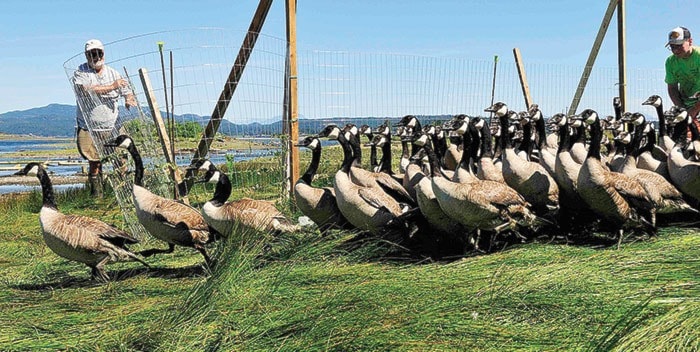A rare roundup was held last weekend in Campbell River, without a single cowboy — or even a cow — anywhere in sight.
Instead, volunteers in kayaks and on shore herded several hundred Canada geese into a pen to be fitted with identifying neck bands, part of a larger effort to protect critical habitat in the Campbell River estuary.
“A concern arose a couple of years ago among people from the city and from Environment Canada that the geese were causing a habitat issue in the estuary,” said Cynthia Bendickson of Greenways Land Trust, which coordinated the waterfowl rodeo. “A preliminary count showed about 1,300 geese there in 2012. That’s a small estuary and a large number of birds.”
Those fears were confirmed this year when environmentalists checked exclosure pens placed in the estuary a year ago, and saw substantial degradation among plants like sedge grass and eelgrass, favourites in the birds’ diet.
“You look in the exclosure and the sedges are more than a metre tall,” said Bendickson. “Just outside, it’s like 10 centimetres.”
The ultimate goal is to reduce the numbers of geese in the estuary, which have exploded since they were introduced to create hunting opportunities in the 1970’s and ‘80s.
During that period there was even a breeding program for the birds on Vancouver Island.
“There are people who say, ‘They’re part of the natural environment; leave them alone,’” Bendickson said. “But this is not natural.
“We have survey data from an 18-month period in the mid-1980s that counted 31 geese in the estuary.”
The options for thinning the flock include egg addling — shaking eggs in the nest to kill them and leaving them in place so the parents do not resume breeding — increasing the hunting bag limit in the region; or a cull, which Bendickson said is the least likely solution.
All of those solutions involve receiving approval from regulatory agencies, so last weekend’s banding, the first of its kind in the estuary, was taken as a step to provide data on the birds’ movement within the region.
Greenways Land Trust wants to hear from anybody who spots one of the banded birds, whether it’s found in a York Road farm field, a back yard off Oyster River or in local lakes. The bands are white and boast large, dark numbers that should be easy to read with the aid of binoculars.
“If people could provide GPS coordinates, that would be awesome,” said Bendickson. “Or at least a general map location.”
The timing of last weekend’s banding was not coincidental. The geese arrived at the estuary in a “molt” migration, after which they temporarily lose their flight feathers. Volunteers with plastic fencing on shore teamed up with herders from Campbell River Kayak Club to swim and march the geese to a waiting pen.
There, they were secured, given a metal leg tag and the larger, plastic neck band by qualified bird banders from the Guardians of Mid-Island Estuaries Society in Parksville.
“Of course, the banders have done lots of banding, including big birds like Canada goose,” said Tim Innes, BC Regional Director for the Nature Conservancy of Canada. “But rounding them up into a pen by kayak was a novelty, for sure. No one could quite believe how flawlessly the plan was executed.”
The project also involved Fisheries and Oceans Canada, the Campbell River Fish and Wildlife Club, the Pacific Salmon Foundation, the Campbell River Environmental Committee and Environment Canada.
To report a sighting of a banded goose, contact Greenways Land Trust at 250-287-3785 or greenways@greenwaystrust.ca.
